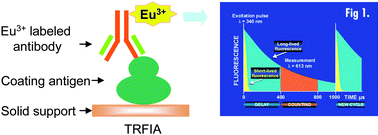Development of a sensitive time-resolved fluoroimmunoassay for organophosphorus pesticides in environmental water samples
Abstract
Due to the large-scale use of

Maintenance work is planned for Wednesday 1st May 2024 from 9:00am to 11:00am (BST).
During this time, the performance of our website may be affected - searches may run slowly and some pages may be temporarily unavailable. If this happens, please try refreshing your web browser or try waiting two to three minutes before trying again.
We apologise for any inconvenience this might cause and thank you for your patience.
* Corresponding authors
a
Guangdong Provincial Key Laboratory of Food Quality and Safety, College of Food Science, South China Agricultural University, No. 483, Wushan Road, Tianhe District, Guangzhou 510642, Guangdong, China
E-mail:
ymsun@scau.edu.cn
Fax: +86 20 37253821
Tel: +86 20 37252525
b Key Laboratory of Plant Resources Conservation and Sustainable Utilization, South China Botanical Garden, Chinese Academy of Sciences, Guangzhou 510650, China
Due to the large-scale use of

 Please wait while we load your content...
Something went wrong. Try again?
Please wait while we load your content...
Something went wrong. Try again?
Z. Xu, J. Dong, J. Yang, H. Wang, Y. Jiang, H. Lei, Y. Shen and Y. Sun, Anal. Methods, 2012, 4, 3484 DOI: 10.1039/C2AY25534K
To request permission to reproduce material from this article, please go to the Copyright Clearance Center request page.
If you are an author contributing to an RSC publication, you do not need to request permission provided correct acknowledgement is given.
If you are the author of this article, you do not need to request permission to reproduce figures and diagrams provided correct acknowledgement is given. If you want to reproduce the whole article in a third-party publication (excluding your thesis/dissertation for which permission is not required) please go to the Copyright Clearance Center request page.
Read more about how to correctly acknowledge RSC content.
 Fetching data from CrossRef.
Fetching data from CrossRef.
This may take some time to load.
Loading related content
